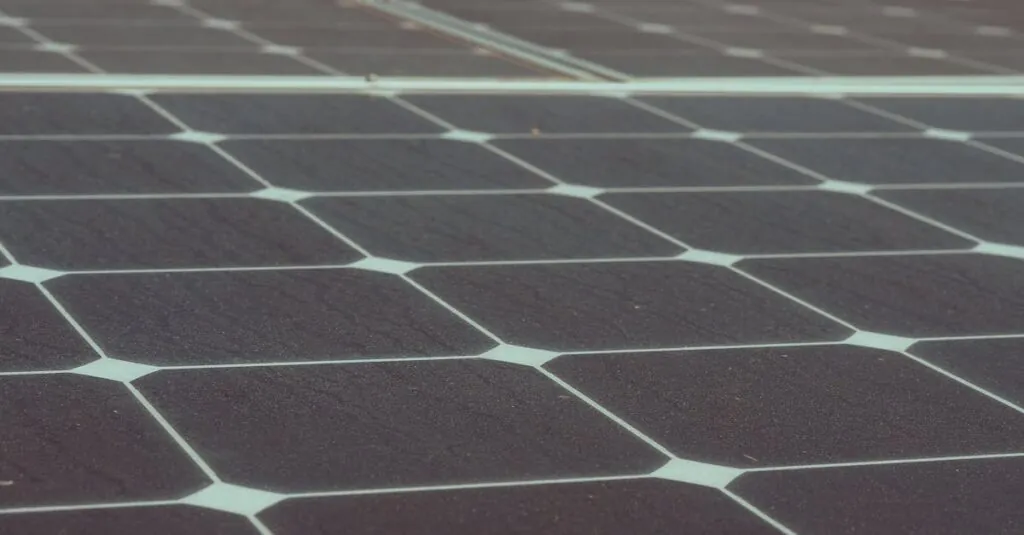In a world where the sun shines brighter than your neighbor’s new car and the wind blows with the enthusiasm of a toddler at a birthday party, renewable energy solutions are stepping into the spotlight. Gone are the days of fossil fuels playing the lead role in our energy drama. It’s time for solar panels and wind turbines to take center stage and show us how to power our lives without the guilt of Mother Nature shaking her head in disapproval.
Imagine harnessing the sun’s rays to brew your morning coffee or letting the wind whip through your hair while charging your phone. Renewable energy isn’t just a buzzword; it’s a ticket to a cleaner, greener future. With innovative technologies and a dash of humor, this article dives into the exciting world of renewable energy solutions that promise to make our planet a happier place—one solar panel at a time.
Table of Contents
ToggleOverview of Renewable Energy Solutions
Renewable energy solutions encompass various technologies that harness natural resources for power generation. Solar energy stands out as a leading example, utilizing photovoltaic cells to convert sunlight into electricity. In 2022, solar power contributed approximately 20% of the total electricity generated in the U.S. Wind energy follows closely, with wind turbines generating about 9% of the nation’s electricity.
Geothermal energy taps into the Earth’s internal heat, providing a consistent power source. It contributes around 0.4% of the national energy mix but shows promising potential in specific regions. Biomass energy capitalizes on organic materials, like plant waste and wood, transforming them into usable energy and minimizing landfill waste.
Hydropower remains a prominent player in renewable energy, responsible for nearly 37% of the total renewable energy consumed in the U.S. Dams and water flow convert the kinetic energy of moving water into electricity, offering a reliable and continuous power source.
Advantages of renewable energy solutions include reduced greenhouse gas emissions and decreased reliance on fossil fuels. Cost-effective options continue to emerge, driving down prices and increasing accessibility for consumers. Governments and organizations worldwide promote these solutions due to their sustainability and potential for job creation.
Innovative advancements in energy storage technologies, like batteries, further enhance the effectiveness of renewable solutions. They allow for energy to be stored and utilized during peak demand times. This flexibility ensures a stable energy supply, even when natural resources are less available.
The transition to renewable energy solutions significantly influences energy independence and environmental health, enabling a cleaner and more sustainable future.
Types of Renewable Energy Solutions
Various renewable energy solutions harness natural resources. Each type contributes uniquely to the energy landscape, supporting sustainability goals.
Solar Energy
Solar energy captures sunlight through photovoltaic cells. These cells convert solar rays into electricity, accounting for approximately 20% of U.S. electricity generation. With decreasing costs, solar panel installations increase across residential and commercial sectors. Innovations in solar technology enhance efficiency, enabling greater power generation even in low-light conditions. Various incentives further promote solar adoption, making it a popular choice for many.
Wind Energy
Wind energy utilizes turbines to convert wind into electricity. Generating about 9% of the nation’s electricity, wind farms showcase impressive scalability. Turbines can be installed onshore and offshore, maximizing production based on location. Technological advancements lead to larger and more efficient turbines, resulting in increased output. Additionally, wind energy creates jobs and stimulates local economies, bolstering community support for wind projects.
Hydropower
Hydropower relies on flowing water to generate energy. With nearly 37% of total renewable energy consumption, it remains the largest source of renewable electricity in the U.S. Dams and run-of-the-river systems harness kinetic energy from water. Hydropower offers reliable energy storage, providing electricity during peak demands. Sustainable practices in hydropower development enhance environmental compatibility, ensuring the health of aquatic ecosystems.
Biomass Energy
Biomass energy derives from organic materials like plant matter and waste. Various processes convert biomass into heat, electricity, or biofuels. It serves as a versatile energy source, reducing landfill waste while generating energy. Biomass can contribute to regional energy independence by utilizing locally sourced materials. Technologies that improve conversion efficiency make biomass increasingly viable for energy production.
Geothermal Energy
Geothermal energy taps into the Earth’s internal heat for energy generation. This renewable source is particularly efficient, providing a steady power supply. Utilizing hot steam from underground reservoirs, geothermal plants generate electricity continuously. Regions with high geothermal activity, such as the western United States, benefit significantly from this resource. Expanding geothermal technologies enhance its accessibility, promoting further adoption in various settings.
Benefits of Renewable Energy Solutions
Renewable energy solutions offer numerous advantages that promote sustainability and economic growth. These benefits span environmental impacts, economic advantages, and energy independence.
Environmental Impact
Reduced greenhouse gas emissions significantly improve air quality. Utilizing solar panels and wind turbines decreases reliance on fossil fuels, thus minimizing harmful pollutants. Renewable sources such as hydropower generate energy without contributing to climate change, maintaining ecosystems. Lower carbon footprints from renewable energy contribute to healthier environments, promoting biodiversity and wildlife preservation. Additionally, sustainable practices help combat global warming, ensuring future generations inherit a cleaner planet.
Economic Advantages
Renewable energy technologies create job opportunities, driving economic growth. Solar and wind industries have witnessed job creation rates exceeding the national average, supporting local communities. Furthermore, declining costs associated with solar panels and wind turbines enhance affordability for consumers. Investment in renewable energy leads to increased energy accessibility, further stimulating economic development. These technologies can also reduce energy bills for households, providing financial savings over time.
Energy Independence
Switching to renewable energy promotes energy independence for nations and communities. Utilizing local resources such as sunlight and wind reduces reliance on imported fossil fuels. Energy independence strengthens national security, minimizing vulnerability to market fluctuations and geopolitical conflicts. Moreover, diversifying energy sources enhances grid stability, ensuring reliable electricity for all users. This shift enables regions to harness their unique natural energy potentials, fostering greater self-sufficiency.
Challenges in Implementing Renewable Energy Solutions
Implementing renewable energy solutions faces several challenges that can slow progress and affect adoption rates.
Technological Barriers
Technological barriers hinder the growth of renewable energy. Integration of solar panels and wind turbines into existing energy infrastructure presents difficulties. Grid systems often require upgrades to accommodate fluctuating energy outputs, complicating installations. Limited access to advanced energy storage systems reduces the effectiveness of these technologies. Maintenance and reliability issues also arise, especially in regions with extreme weather, decreasing efficiency. Addressing these challenges involves investing in research and development to enhance technology and create more reliable systems.
Financial Constraints
Financial constraints significantly impact the adoption of renewable energy solutions. High initial costs deter many consumers and businesses from transitioning to solar, wind, or other renewable sources. Despite decreasing prices for solar panels and wind turbines, upfront investments often remain substantial. Complicated financing structures and limited availability of incentives can further complicate the decision-making process. In many cases, securing funding for large-scale projects becomes a barrier. Increasing awareness of long-term savings and creating attractive financing options helps alleviate these financial challenges.
Policy and Regulatory Issues
Policy and regulatory issues affect the growth of renewable energy sources. Confusing regulations and inconsistent policies across states create uncertainty for investors and developers. Lack of supportive legislation can stall project approvals and delay implementation timelines. Permitting processes can take months or years, complicating project feasibility. State and federal policies must provide clear incentives for renewable energy adoption, such as tax credits and rebates. Streamlining processes and promoting collaboration among stakeholders encourages a more favorable environment for renewable energy solutions.
Future of Renewable Energy Solutions
Innovations in renewable energy solutions continue to emerge, promising exciting advancements. Companies invest in next-generation solar panels that increase efficiency and reduce costs. Researchers explore advanced wind turbine designs that enhance energy capture in various conditions. Energy storage technology also rapidly evolves, enabling greater capacity and longevity. Innovations such as smart grids facilitate better energy distribution, making renewables more reliable.
Innovations on the Horizon
Upcoming innovations set the stage for a transformative energy landscape. Solid-state batteries enhance energy storage efficiency while minimizing environmental impact. Breakthroughs in hydrogen fuel cells could provide a clean energy alternative for transportation. AI and machine learning optimize energy management, predicting supply and demand more effectively. Robotic systems improve maintenance for both solar and wind energy infrastructure, reducing operational costs.
Global Trends and Adaptations
Global trends reflect a shift towards embracing renewable energy solutions. Many nations commit to ambitious carbon neutrality goals by 2050, pushing for substantial investment in renewables. Economies in Europe and Asia lead in adopting solar and wind technologies at scale. Policy frameworks evolve, encouraging decentralized energy generation and community participation. The International Energy Agency reports that renewables could supply 80% of global electricity by 2050, emphasizing the need for cooperative international efforts.
The transition to renewable energy solutions is essential for a sustainable future. By harnessing natural resources like sunlight and wind, society can significantly reduce greenhouse gas emissions and reliance on fossil fuels. The advancements in technology are making these solutions more accessible and cost-effective for consumers.
As nations commit to ambitious carbon neutrality goals, the momentum behind renewable energy continues to grow. While challenges remain, the potential for job creation and economic stimulation through these technologies is undeniable. Embracing renewable energy not only fosters energy independence but also paves the way for a cleaner planet. The future of energy is bright and full of promise.






